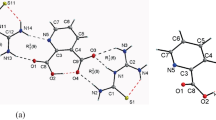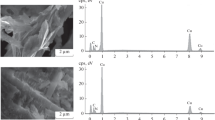Abstract
To determine the structure of mercury, cadmium and zinc complexes of ethyl–phenyl and butyl–phenyl dithiocarbamates and their geometric parameters (bond length and angles), IR and NMR spectroscopes, electrical (HOMO and LUMO) properties, Mulliken atomic charges and molecular electrostatic potential (MEP) surfaces have been theoretically calculated utilizing the Gaussian 09 software. Computed theoretical parameters of metal complexes have also been compared with the experimental parameters. All of the calculations performed in the Gaussian 09 software have been fulfilled in the LanL2DZ set with the density functional theory (DFT/B3LYP and DFT/HSEH1PBE) method. Moreover, DNA interactions have been viewed employing the molecular docking analysis.








Similar content being viewed by others
References
Hogarth, G.: Transition metal dithiocarbamates. Prog. Inorg. Chem. 53, 71 (2005). https://doi.org/10.1002/0471725587.ch2
Ivanov, A.V.; Rodyna, T.; Antzutkin, O.N.: Structural organisation of [Ni(II)–Me(II)–Dtc] (Me = Zn, Cd, Hg) dithiocarbamate complexes: ESR 13C and 15N CP/MAS NMR studies. Polyhedron 17, 3101–3109 (1998)
Sagdinc, S.; Pir, H.: Spectroscopic and DFT studies of flurbiprofen as dimer and its Cu(II) and Hg(II) complexes. Spectrochim. Acta Part A 73, 181–194 (2009). https://doi.org/10.1016/j.saa.2009.02.022
Al Hamouz, O.C.S.: New phenol–glycol cross-linked polymers for efficient removal of mercury from aqueous solutions. Arab. J. Sci. Eng. 43, 211–219 (2018). https://doi.org/10.1007/s13369-017-2847-x
Deeming, A.J.; Forth, C.S.; Hogarth, G.: Synthesis and crystal structure of [Ru8(l5-S)2(l4-S)(l3-S)(l-CNMe2)2(l-CO)(CO)15] formed via the double sulphur–carbon bond cleavage of dithiocarbamate ligands. J. Organomet. Chem. 692, 4000–4004 (2007). https://doi.org/10.1016/j.jorganchem.2007.05.044
Samara, C.D.; Tsotsou, G.; Ekateriniadou, L.V.; Kotsarris, A.H.; Raptopoulou, C.P.; Terzis, A.; Kyriakidis, D.A.; Kessisoglou, D.P.: Anti-inflammatory drugs interacting with Zn(II), Cd(II) and Pt(II) metal ions. J. Inorg. Biochem. 71, 171–179 (1998). https://doi.org/10.1016/s0162-0134(98)10051-x
Frisch, M.J.; Trucks, G.W.; Schlegel, H.B.; Scuseria, G.E.; Robb, M.A.; Cheeseman, J.R.; Scalmani, G.; Barone, V.; Mennucci, B.; Petersson, G.A.; Nakatsuji, H.; Caricato, M.; Li, X.; Hratchian, H.P.; Izmaylov, A.F.; Bloino, J.; Zheng, G.; Sonnenberg, J.L.; Hada, M.; Ehara, M.; Toyota, K.; Fukuda, R.; Hasegawa, J.; Ishida, M.; Nakajima, T.; Honda, Y.; Kitao, O.; Nakai, H.; Vreven, T.; Montgomery Jr., J.A.; Peralta, J.E.; Ogliaro, F.; Bearpark, M.; Heyd, J.J.; Brothers, E.; Kudin, K.N.; Staroverov, V.N.; Kobayashi, R.; Normand, J.; Raghavachari, K.; Rendell, A.; Burant, J.C.; Iyengar, S.S.; Tomasi, J.; Cossi, M.; Rega, N.; Millam, N.J.; Klene, M.; Knox, J.E.; Cross, J.B.; Bakken, V.; Adamo, C.; Jaramillo, J.; Gomperts, R.; Stratmann, R.E.; Yazyev, O.; Austin, A.J.; Cammi, R.; Pomelli, C.; Ochterski, J.W.; Martin, R.L.; Morokuma, K.; Zakrzewski, V.G.; Voth, G.A.; Salvador, P.; Dannenberg, J.J.; Dapprich, S.; Daniels, A.D.; Farkas, Ö.; Foresman, J.B.; Ortiz, J.V.; Cioslowski, J.; Fox, D.J.: Gaussian, Inc., Wallingford CT Gaussian 09, Revision A.1. Gaussian, Inc., Wallingford (2009)
Dennington, R.; Keith, T.; Millam, J.: GaussView, version 5. Semichem Inc., Shawnee Mission (2009)
Lee, C.; Yang, W.; Parr, R.G.: Development of the Colle–Salvetti correlation-energy formula into a functional of the electron density. Phys. Rev. B 37, 785–789 (1988)
Becke, A.D.: Density-functional thermochemistry. III. The role of exact exchange. J. Chem. Phys. 98, 5648–5652 (1993)
Heyd, J.; Scuseria, G.: Efficient hybrid density functional calculations in solids: Assessment of the Heyd–Scuseria–Ernzerhof screened Coulomb hybrid functional. J. Chem. Phys. 121, 1187 (2004). https://doi.org/10.1063/1.1760074
Heyd, J.; Scuseria, G.E.: Assessment and validation of a screened Coulomb hybrid density functional. J. Chem. Phys. 120, 7274 (2004). https://doi.org/10.1063/1.1668634
Heyd, J.; Peralta, J.E.; Scuseria, G.E.; Martin, R.L.: Energy band gaps and lattice parameters evaluated with the Heyd–Scuseria–Ernzerhof screened hybrid functional. J. Chem. Phys. 123, 174101 (2005). https://doi.org/10.1063/1.2085170
Heyd, J.; Scuseria, G.E.; Ernzerhof, M.: Hybrid functionals based on a screened Coulomb potential. J. Chem. Phys. 124, 219906 (2006). https://doi.org/10.1063/1.2204597
Hay, P.J.; Wadt, W.R.: Ab initio effective core potentials for molecular calculations. Potentials for the transition metal atoms Sc to Hg. J. Chem. Phys. 82, 270 (1985). https://doi.org/10.1063/1.448799
Wadt, W.R.; Hay, P.J.: Ab initio effective core potentials for molecular calculations. Potentials for main group elements Na to Bi. J. Chem. Phys. 82, 284 (1985). https://doi.org/10.1063/1.448800
Hay, P.J.; Wadt, W.R.: Ab initio effective core potentials for molecular calculations. Potentials for K to Au including the outermost core orbitals. J. Chem. Phys. 82, 299 (1985). https://doi.org/10.1063/1.448800
Morris, G.M.; Huey, R.; Lindstrom, W.; Sanner, M.F.; Belew, R.K.; Goodsell, D.S.; Olson, A.J.: AutoDock4 and AutoDockTools4: automated docking with selective receptor flexibility. J. Comput. Chem. 30, 2785–2791 (2009). https://doi.org/10.1002/jcc.21256
Onwudiwe, D.C.; Ajibade, P.A.: Synthesis and characterization of Zn(II), Cd(II), and Hg(II) alkyl-aryl dithiocarbamate: X-ray crystal structure of [(C6H5N(et)CS2)Hg(C6H5N(butyl)CS2)]. Synth. React. Inorg. Met. Org. Nano Met. Chem. 40, 279–284 (2010). https://doi.org/10.1080/15533171003766717
Pir, H.; Günay, N.; Avcı, D.; Tamer, Ö.; Tarcan, E.; Atalay, Y.: Theoretical investigation of 6-(3,3,4,4,4-pentafluoro-2-hydroxy-1-butenyl)-2,4-dimethoxy-pyrimidine molecule. Arab. J. Sci. Eng. 39(7), 5799–5814 (2014). https://doi.org/10.1007/s13369-014-1131-6
Pearson, R.: Absolute electronegativity and hardness: applications to organic chemistry. J. Org. Chem. 54, 1423–1430 (1989)
Mulliken, R.S.: Electronic population analysis on LCAO-MO molecular wave functions. I. J. Chem. Phys. 23, 833–1840 (1955). https://doi.org/10.1063/1.1740588
Cramer, J.C.: Essentials of Computational Chemistry. Theory and Models, vol. 596. Wiley, New York (2002)
Lipkowitz, K.B.; Boyd, D.B.: Successes of Computer-Assisted Molecular Design, Reviews in Computational Chemistry, vol. 45. Wiley, New York (1990)
Morris, G.M.; Goodsell, D.S.; Pique, M.E.; Lindstrom, W.; Huey, R.; Forli, S.; Hart, W.E.; Halliday, S.; Belew, R.; Olson, A.J.: User Guide AutoDock Version 4.2. Automated Docking of Flexible Ligands to Flexible Receptors (2010). http://autodock.scripps.edu/faqs-help/manual/autodock-4-2-user-guide/AutoDock4.2_UserGuide.pdf. Accessed 11 Oct 2010
Alam, M.; Kim, Y.; Park, S.: Quantum chemical calculations, spectroscopic studies and biological activity of organic–inorganic hybrid compound (2,2-dimethylpropane-1,3-diammonium) tetrachlorozincate(II). Arab. J. Sci. Eng. 44, 631–645 (2019). https://doi.org/10.1007/s13369-018-3573-8
Author information
Authors and Affiliations
Corresponding author
Rights and permissions
About this article
Cite this article
Gümüş, H. Spectroscopic (Vibrational and NMR) Characterizations and Molecular Docking Analysis of Zn(II), Cd(II) and Hg(II) Complexes with Alkyl–Aryl Dithiocarbamates. Arab J Sci Eng 45, 4929–4937 (2020). https://doi.org/10.1007/s13369-020-04358-0
Received:
Accepted:
Published:
Issue Date:
DOI: https://doi.org/10.1007/s13369-020-04358-0




